Martin Got it Right with the New and Improved 16 Series
Rosewoods and Ovangkol = Impressive Tone
I am preparing a review of each 16 Series Martin, but I am also preparing to leave for the annual Martinfest. So, until I can return to writing guitar reviews next week, here is my review of the new 16 Series as a whole:
“Four Stars! The best-sounding 16s in a quarter of a century.” – One Man’s Guitar
C. F. Martin & Co. debuted a new and improved 16 Series at the Summer NAMM show in Nashville, Tennessee, featuring acoustic-electric models based around rosewood guitars with spruce tops, beginning with four new or improved models: the D-16E, GPC-16E, 000-16E, and 00-16E.
They also released two ovangkol acoustic-electric models constructed with ovangkol tops, the D-16E Burst and OMC-16E Burst.
While I enjoy the new looks of these guitars, what I really care about is tone. So, I avoided the noisy trade show floor, and went instead to the Martin Guitar factory in Nazareth, PA, where I could play and hear these impressive new offerings in the secluded, acoustically-treated confines of Martin’s sound testing room.
Let there be no doubts about it, the 16 Series instruments are by design a collection of acoustic-electric guitars meant for the professional concert stage. None of the new models has a stamp on the neck block with an “E” in it, because there are no more 16s made without a fully adjustable electronic pickup system installed at the factory as a standard feature. That being Fishman’s Matrix VT Enhance system, which has an undersaddle pickup with tone and volume controls working in combination with a bridge plate sensor blended in by a third control. All of them discretely placed inside the guitar.
Acoustic Guitars First and Foremost
But they also sound very good when played unplugged as acoustic guitars. And this, despite a Dreadnought and a Grand Performance size instrument that are made with their depth reduced to that of the 000 and 00 models.
This improved tone is due in part to the robot-created Simple Dovetail neck joint that Martin introduced a few years back to replace Mortise and Tendon neck joint that was first used on Style 16 Martins in 1995. While today’s 16s do not offer the exact same fullness of tone or wide ranging dynamics as models from the Standard Series made with the full-size hand-fitted dovetail neck joint set into a solid mahogany neck block, it is an inestimable improvement over M & T joint and the extra bracing required to support it.
When used in combination with a solid ebony bridge, today’s 16 Series instruments are deservedly in a different league to the earlier generations that just seemed full of cost cutter specs like fretboards and bridges made of various non-wood materials. Of the new models, the D-16E is closest to its immediate rosewood predecessor, the D-16RGT, with the side depth being perhaps the most notable difference. But I feel it sounds surprisingly good, with tone better than I remember hearing from a 16 in a long time. But then, I was even more impressed with the GPC-16E.
The primary reason for this reduction in depth is to curtail the problems of electronically amplifying an exceptionally resonant acoustic guitar like a Martin. I was skeptical of this new dreadnought with its shallower sides. But it still sound like a dreadnought, with much more growl and soul in the heart of its voice than I thought possible before I picked it up and gave it a strum.
The trade off is that it does not have the big bulbous bass note at the very bottom, which dreadnought lovers find so satisfying. But frankly, there are a lot of full-size dreadnoughts on the market that do not have the bass in the bottom E string as this new Martin. It has been curtailed some, but it is still there.
The GPC-16E likewise has the side depth of a 00, 000, and OM. And that has proved a revelation. Where the D model has a dominant A string, not unlike an OM in this respect, the GPC-16E retains the dominant bottom E string, while achieving a voice more spread out and spacious compared to the typical Grand Performance or other small jumbo guitars on the market.
Martin may have stumbled on that long-sought super-OM kind of sound, with the balance and dynamics of a good OM but with just a little more bass that frees that low E string from the gravity of wolfish A string. And like its D-size sibling, the rosewood back and sides, forward-shifted scalloped bracing, and a solid ebony bridge give it a luxuriously complex tonal pallet, with leaping sympathetics and an effortless body resonance that other leading guitarmakers have been reinventing the wheel to try and achieve, with limited success.
A bonus feature of the shallow sides is that they make these two large-top guitars more comfortable to play for not-so-large guitarists.
Looks Like a Martin, Smells Like a Martin, Sounds Like a Martin
For about a decade, Martin invested a certain percentage of their design efforts in creating products with an image, feel, and sound that might compete for consumers who have become enamored of contemporary brands and guitar styles made elsewhere. It seems lately that Martin has returned to focusing on what they have always done best – full-bodied acoustic tone, naturally resonant and complex, generated from a guitar with classic acoustic guitar looks. And even with the various body shapes they borrowed from other brands in recent years, they have stopped trying to make their version of trendy, hipster guitars, and used the shapes to create true Martins with the kind of tone that can’t be had anywhere else, and the kind of aesthetic that is Martin in origin, and even, dare I say it, traditional.
The new 2019 16s are made with Standard Series features like Antique White biding on the top and back, Style 28 mother-of-pearl fretboard dots to go along with the vintage-esque open-back tuning machines, and Old Style script logo, while retaining the fanciest of the various Style 16 top trim used over the years, the herringbone rosette and double line top purfling that are a simplified variation of inlays seen on Style 21 guitars from the pre-war era.
So now, the gloss top makes a D-16 look just like a Standard Series Martin from the front, while the body has a satin finish. Satin finish may not be a Standard Series spec, but there are many world-class guitars made that way, with George Lowden’s instruments as a prime example. What is a Standard Series feature is the full complement of scalloped bracing, with the larger bodies having their bracing pattern forward-shifted in the pre-war fashion, to maximize bass response and get the most out of that rosewood resonance.
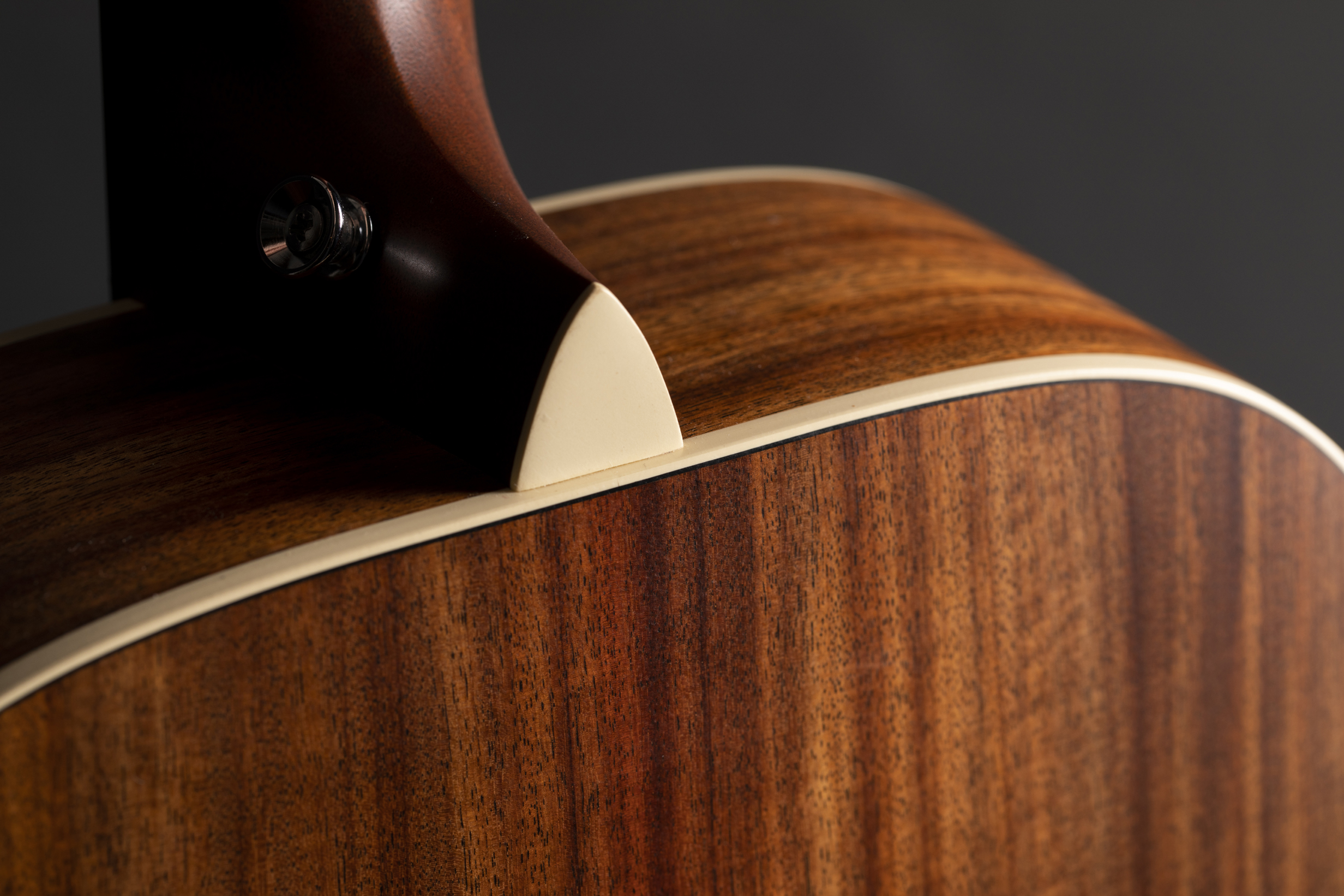 |
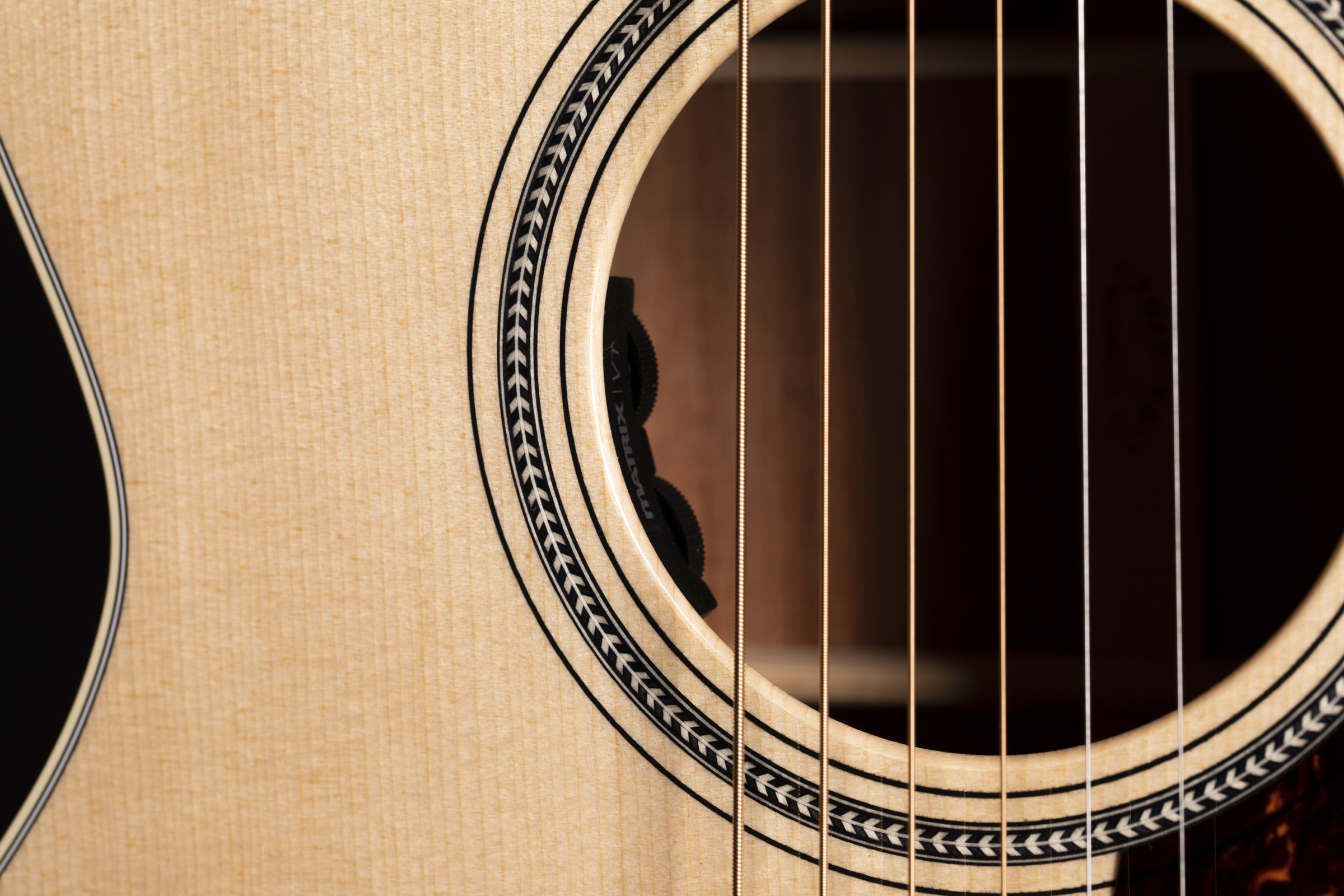 |
 |
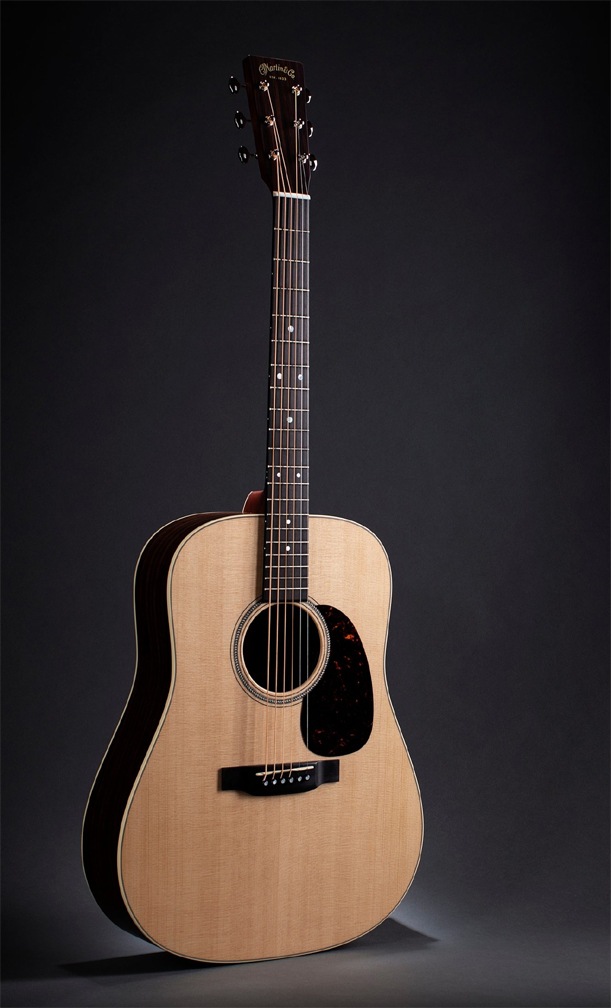 |
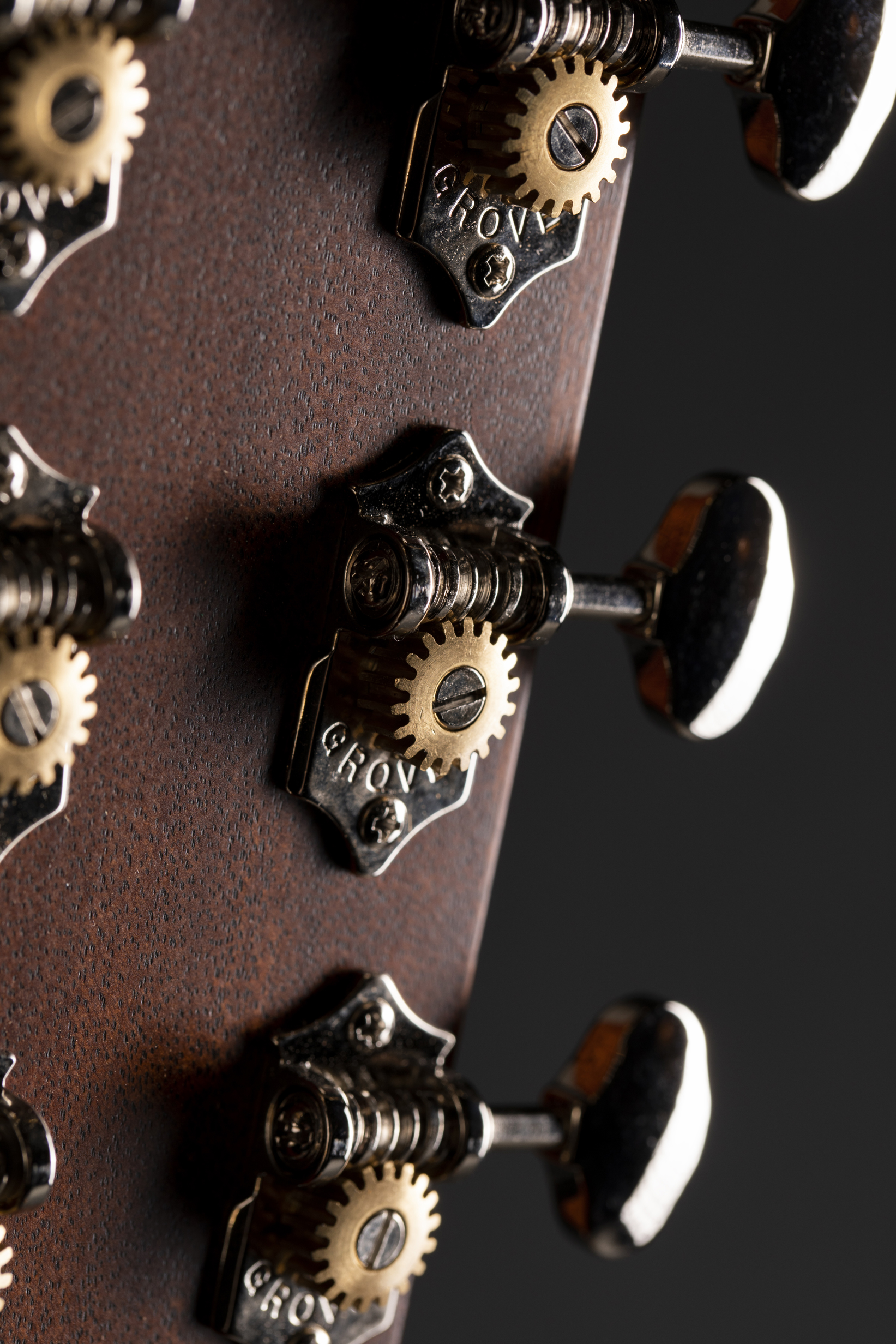 |
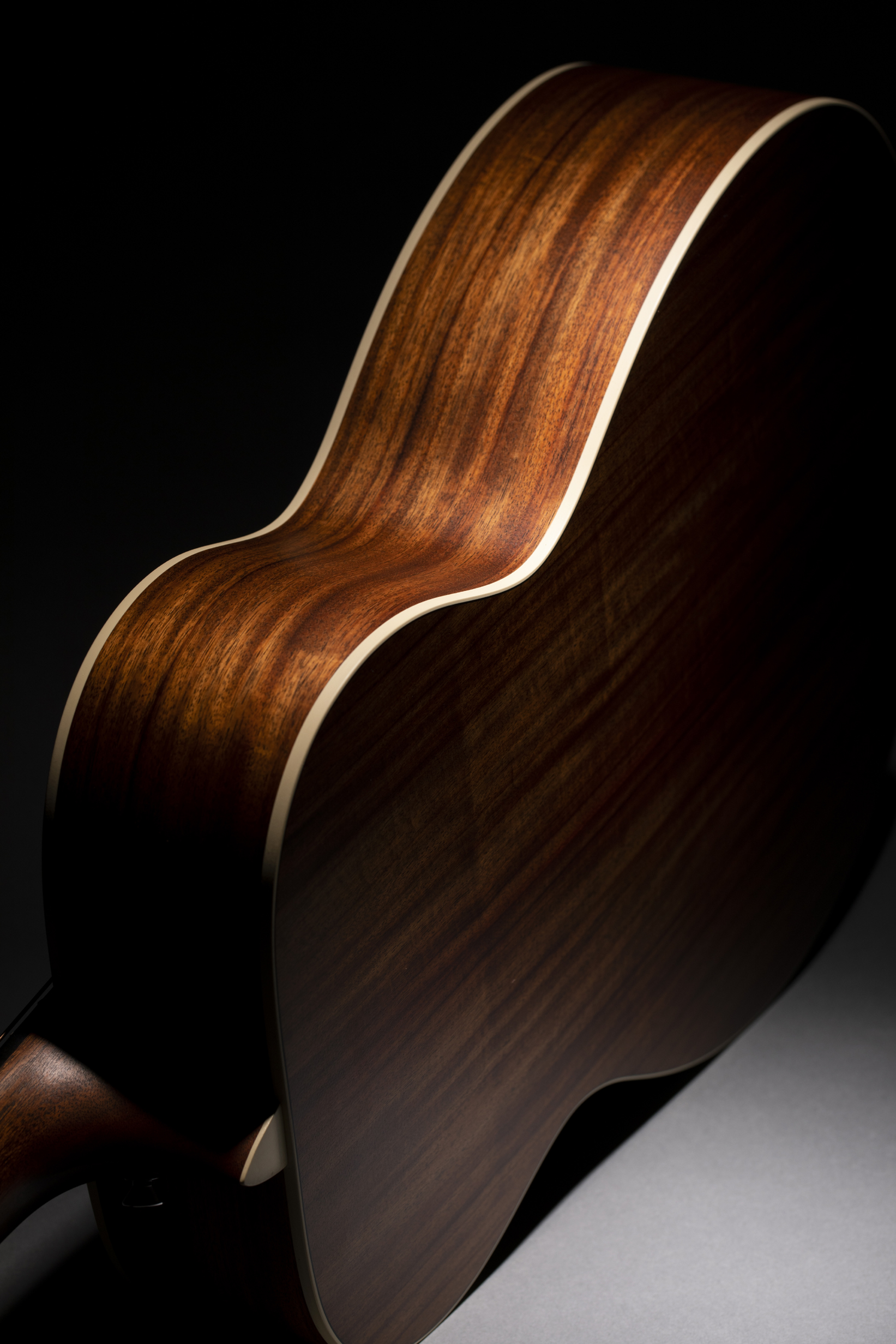 |
To be entirely accurate, only the D-16E and GPC-16E have a back and sides made from East Indian rosewood. The 000-16E and 00-16E are made from granadillo, which is not technically a rosewood. It is a species of Platymiscium that Classical guitarmakers sometimes called Mexican rosewood, because it can resemble cocobolo rosewood in terms of density and Guatemalan rosewood in terms of a thick, full-bodied tone that works very well indeed for beefing up the bottom end of small-bodied guitars. It certainly sounds more like rosewood than it doesn’t.
But granadillo is also notably heavier than Indian rosewood. And that is probably why Martin chose not to use it for the Dreadnought and Grand Performance models. They would have seemed abnormally weighty in the hand, and the undertone of the lower-mids might have been too dense and murky for bodies already putting out a lot of bass frequencies.
The 000-16E has its own satisfying body resonance and the sort of bottom end beef that a short-scale Martin 000 should have, Its slightly smaller sibling, the 00 has less muscle in its guts but has the prominent fundamentals of a great Blues machine and the added comfort of the smallest top width of the new 16 Series. And both are made with the 24.9” short scale High Performance Neck, which I find exceptionally comfortable, as Modified Low Oval profiles go.
And all of these new models mentioned are wonderfully expressive and have very pretty trebles when played within the zone of optimum resonance. And while they can start to sound thin up top when under serious attack, they do not have the shrill harshness that often plagued 16 Series guitars from previous eras.
Stylish Style 16
From the outsides, the spruce-topped models have a traditional appearance that ties directly into the pricier Standard Series instruments, while the ovangkol models have the Mahogany Burst of the 15 Series Streetmaster models, upgraded with faux tortoise bindings. It can be generally said that the ovangkol models offer a step up from the 15 Series instruments, while the new spruce-topped 16s have taken a step or two toward the Standard Series, in more than just looks.
While the new models look quite a bit different than the 16s they are replacing, they have the same internal construction. Those now-retired 16s had been “reimagined” with silver-colored binding and orange and black top trim that was borrowed from design schemes in the automotive industry. Initially dubbed the “Americana Series,” they featured back and side woods sourced within the USA. There was an OMC made from cherry, a GPC with 000 depth made from koa, and a D and DC made with 000 depth from sycamore.
Those late models can still be found for sale in shops, and they are well liked by those who have purchased them. But when the 16 Series instruments had a acquired a reputation for tone that was more lightweight or thin compared to the full-bodied heavy hitters in the Standard Series, using tonewoods that do not have the rich bass response and tonal complexity of rosewood and tropical American mahogany wasn’t doing the silver-bound Martins any favors, in terms of broad appeal and resulting sales. And neither were their unusual looks.
Herringbone trim was long gone from the Martin catalog when Style 16 first appeared in 1961. At the time it was meant to offer mahogany guitars with the same construction as Style 18 instruments, but with simpler appointments and a lower price tag, in much the same way Style 21 allowed for more-affordable rosewood models than Style 28. Style 21 vanished in the 1960s and Style 16 not long after.
When Style 16 reappeared in the 1980s, it was a catchall designation for trade show specials that were not for wider sale, but allowed Martin to try out various outside-the-box designs. Eventually, the first D-16s were offered for general sale in mahogany, ash, walnut, and koa. In the early ‘90s the D-16 offered mahogany guitars with scalloped, forward-shifted bracing as well as tortoise binding and pickguards, when the D-18 and 000-18 still had black trim and non-scalloped, non-forward bracing.
In 1995, the “16 Series” was launched as a collection of “new technology” guitars, losing the traditional hand-fitted dovetail neck joint and solid mahogany blocks, and adopting an ever-changing list of specs, neck shapes, woods, non-woods, and all sorts of on-board electronics. And this spirit of innovation at affordable prices continues in the new D-16E Burst and OMC-16E Burst, made with ovangkol back, sides, and top.
 |
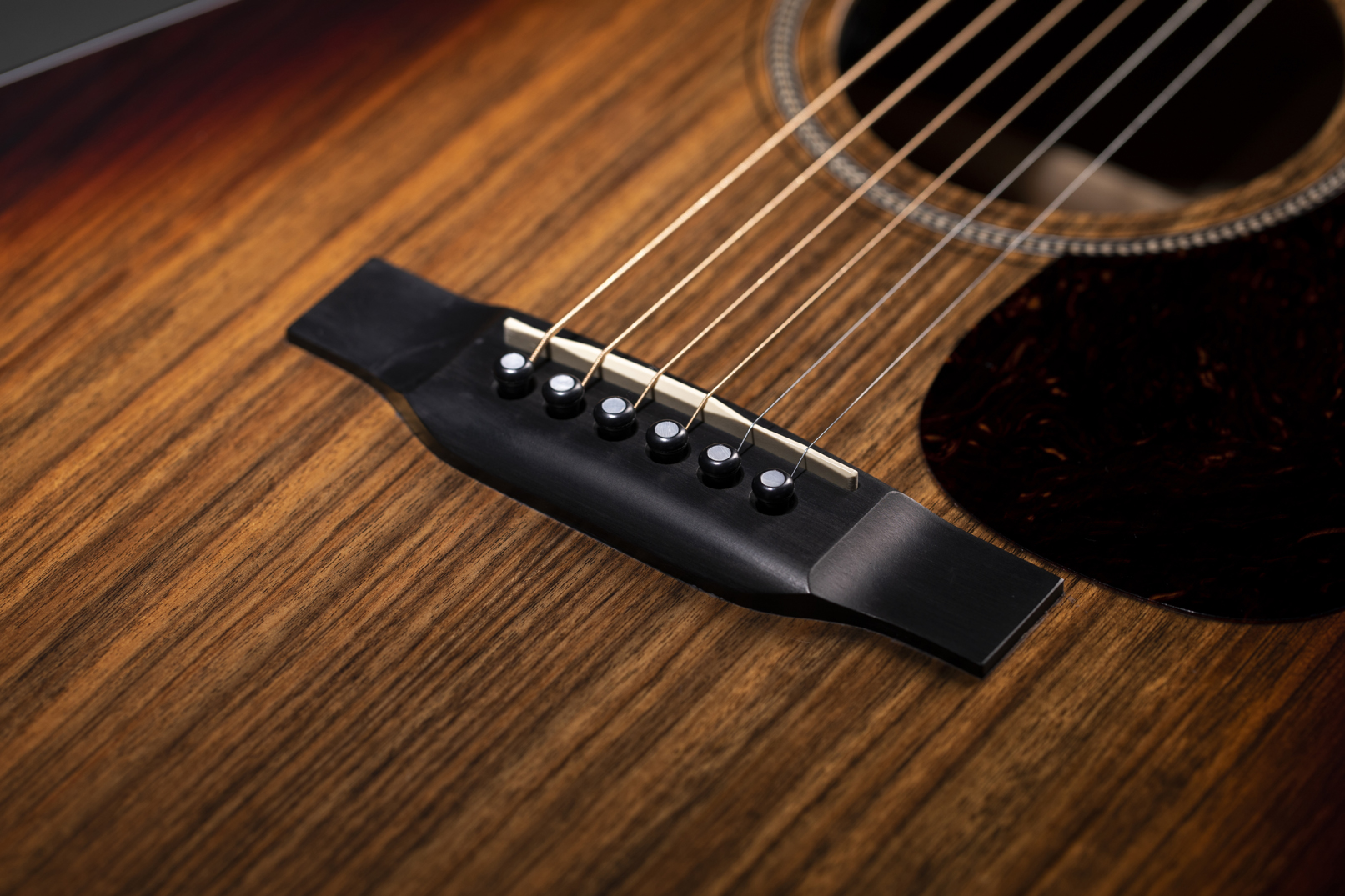 |
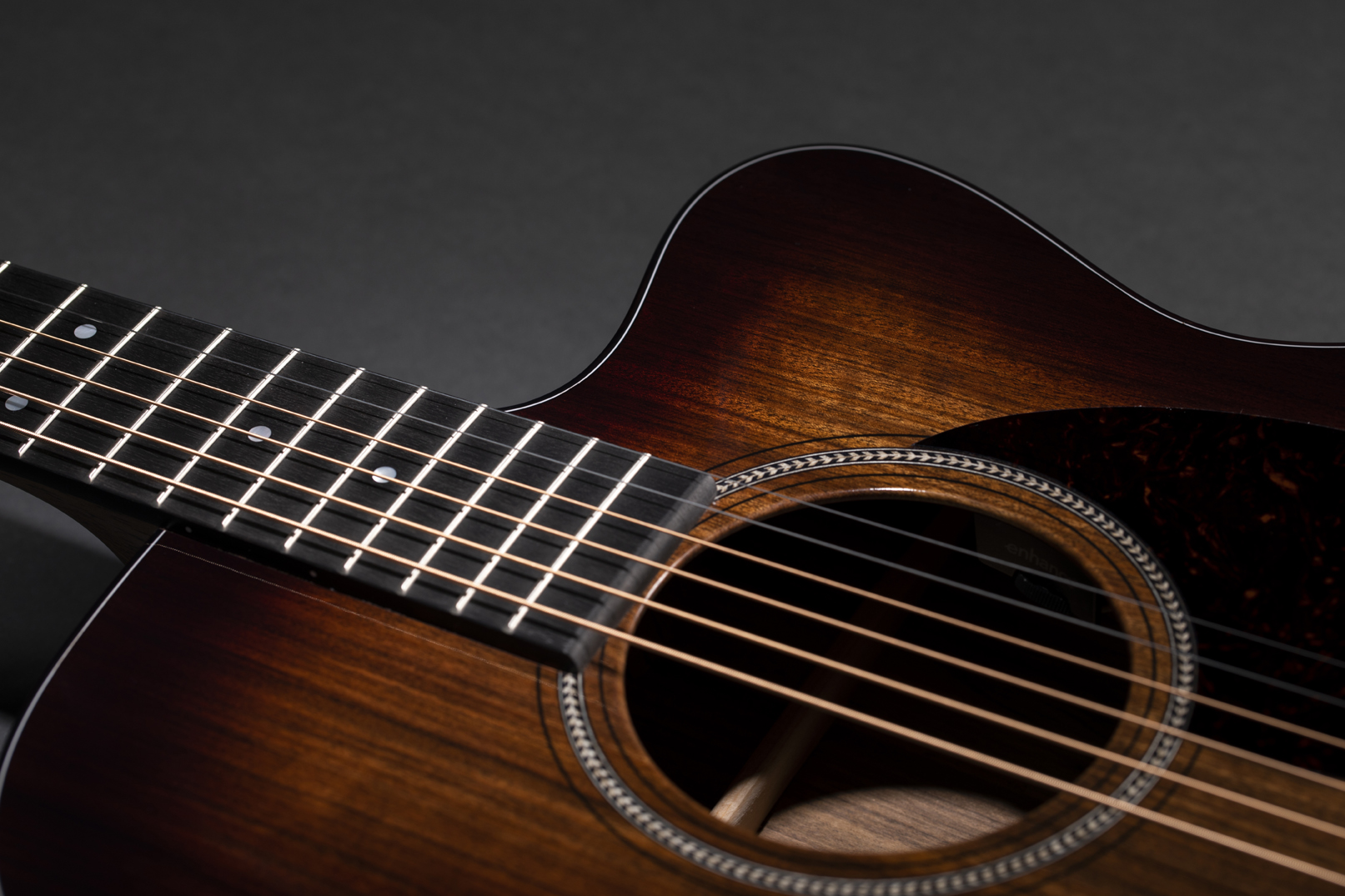 |
I have always loved the looks of guitars made with a hardwood top. And these new 16 Burst models are about as good as it gets. They will draw a lot of attention in guitar shops and their unique tone will stand up to that first attraction.
Ovangkol is an African wood that sounds something along the lines of Claro walnut, to my ear. Warmth and overtones, but never in extreme amounts. One of those “in between rosewood and mahogany” tonewoods, I was pleasantly surprised at how well it works as top wood. Mahogany, koa, and walnut have all been used as tops on Martins over the years. Each produces its own mellow presence without the vibrancy or volume of spruce. But they sound sweeter the longer they age even if they take a while to break in.
Well, these two ovangkol Martins do not have same sort of muffled tone typical of hardwood tops when they are brand new. So while it has that soft lamplight glow from the wound strings similar to an all-mahogany guitar, there is more openness and focused clarity as well, particularly where the unwound treble strings are concerned. And yet they seem to also have the clear and straightforward sustain that made mahogany and koa tops a favorite for players of steel guitar.
The 16 Series as always been a place where Martin Guitar could introduce new looks and new specs and see how well they do with consumers. And the ovangkol Burst models are the latest release to try those trade winds and see if they can sink or float. Time will tell. But I think they are pretty swell.
I have never encountered a guitar before with an ovangkol top, so I look forward to seeing how they will age and play-in. Right now they are quieter and easier to overdrive than their spruce-topped counterparts. That should improve with time, especially since they get the same traditional Martin bracing, rather than the simplified A-frame X bracing used on the 15 Series.
When played in a relaxed manner, they both sound absolutely lovely, with the OMC-16E Burst alive with sprightly overtones. It is when a guitarist digs in and plays hard that they sort of wimp out, overdrive and get spanky, especially the treble strings. But that is an issue for all Martins made without the traditional dovetail neck joint. The hardwood top just makes it more obvious.
Most people do not play as hard as I do, so what I might hear as deficiencies between the 16 Series Martins and the Standard Series models may go entirely unnoticed by many guitarists. Certainly some players will prefer the tone of the 16s to other Martins. And it is basically a moot point once they plug in and go electric.
What is important is that the acoustic tone of these new 16s is 100% Martin and truly satisfying. This is not a matter of having to go without to save some money.
I have no problem recommending them to anyone looking for a good deal on a good guitar in that price range. There have been many times over the past 25 years when I couldn’t say that about a Style 16 instrument. But the 2019 Martin 16 Series is the real deal, and at those prices, a steal.
And that’s one man’s word on…
Martin 16 Series for 2019
Here is the GPC-16E…
Written reviews begin next week, when I get back from Martinfest, in the mean time, here are the video reviews.

One thought on “2019 Martin Models Review: 16 Series – All of Them!”